

Virtual Backgrounds for School. UMsimulations - ImagineNation Matters. For ImagineNation Matters 2015, we're proud to offer eighteen story modules for your consideration.

Remember that you and your students can explore one, or if your time permits, two modules over the course of the winter 2015 session, which will run from January 26th through late April. Our mentors will be delighted to work with your students at whatever pace is comfortable for you. Click here to see our PUBLIC site, where you can view many of our modules in their entirety (use the Login: guest and the password: guest) This guest ID starts you on the Our State Government site, but to view other sites, simply click on VISIT OTHER TOURS in the upper right hand corner.As you'll see when you sign on, each module has a welcome page, and the pages of the story are grouped into chapters, viewable along the left hand side. After the welcome page, each page will have a discussion prompt, and a space for the kids to post their responses.
Getting Started. Articles - Issues. The Importance of the Group in Online Learning. Online Learning Sources. Teaching Online. 15 Free Learning Tools You've Probably Never Heard Of. ConfessionsOfTheNOTYs.pdf (application/pdf Object) Online Nation: Five Years of Growth in Online Learning - ED529699.pdf. From both sides now. "I've looked at life from both sides now.
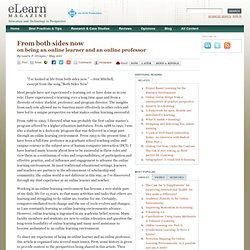
" —Joni Mitchell, excerpt from the song "Both Sides Now" 5 E-Learning Trends for Higher Ed. Case methods for online learning. Case analysis is a popular teaching strategy in higher education, particularly in professional degree programs such as business, social work, education, medicine, law, and policy studies.
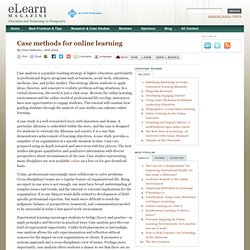
This strategy allows students to apply ideas, theories, and concepts to realistic problem-solving situations. In a virtual classroom, the world is just a click away. Dynamic, Global, Content Sharing: LMS Evolution or the Birth of a New Entity? Online Learning 101: Part I. The first part of this three-part series focuses on authoring and course development tools and techniques for integrating e-learning.
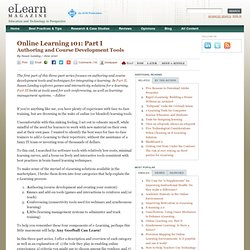
In Part II, Susan Landay explores games and interactivity solutions for e-learning. Part III looks at tools used for web conferencing, as well as learning-management systems. —Editor. Online Learning 101: Part II. Online Learning 101: Part III. My goal in this three-part series of articles has been to recommend the best software tools that are affordable, have minimal learning curves, and focus on lively and interactive tools, consistent with best practices in brain-based learning techniques.
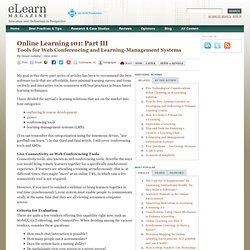
I have divided the myriad e-learning solutions that are on the market into four categories: (You can remember this categorization using the mnemonic device, "any goofball can learn. ") E-learning 2.0. A Place to Call Our Own. Learning has been flipped on its head, with second-hand learning experiences now being converted to first-hand discovery experiences through experiential and problem-based learning [1] . It is commonly recognized that learning no longer occurs only in classrooms; approximately 70 percent of learning occurs in the workplace and in the community as informal learning [2] . These flipped and informal learning experiences require self-directed learners.
However self-directed learning is not synonymous with self-managed learning. This means we will always need the guidance and facilitation of learning curators—educators, mentors, and workplace learning and development managers [3, 4] . This also means as we experience this ongoing development we will need somewhere to house the evidence of our lifelong learning—a place we can call our own, which is not necessarily attached to any formal learning organization or workplace. 1. 2. 3. 4. 5. The Internet and Higher Education - Cutting the distance in distance education: Perspectives on what promotes positive, online learning experiences.
Volume 15, Issue 2, March 2012, Pages 118–126 Special issue of the American Educational Research Association's online teaching and learning special interest group Edited By Steven Terrell Abstract This qualitative research study was designed to inform the development and implementation of effective online learning environments by exploring, from both teacher and student perspectives, what constitute effective online learning experiences.

Mobilizing and Globalizing with Online Education. Whatever the times, education is an important vehicle to rise above certain of life's inequities.

While many countries, including so-called third world nations, have slowly been building their educational systems, America—despite its policies, programs, and good intent—has paid mere lip service to the realization of its educational goals. Consequently, education in many states in America is witnessing a breakdown. For example, in the state of Georgia, high school graduation rates are low, and college graduation rates even lower. Even within these categories, the figures are divided along race and gender lines, with women (especially African-American women) performing higher than their male counterparts. What these figures project for our students' futures, in terms of jobs and the attendant quality of life (let alone gender and race relations), is anyone's guess. Setting aside lofty rhetoric: We must mobilize education! 1. 2. 3. 4.
Predictions for e-Learning in 2011. At the start of each year, eLearn Magazine's editors, advisory board members, and other contributors predict what changes are afoot for the coming 12 months.
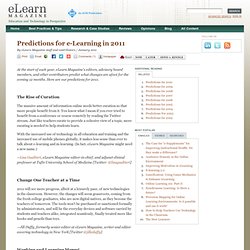
Here are our predictions for 2011. The Rise of Curation The massive amount of information online needs better curation so that more people benefit from it. You know what I mean if you ever tried to benefit from a conference or course remotely by reading the Twitter stream. Just like teachers curate to provide a cohesive view of a topic, more curating is needed to help students learn. Unbolting the chairs. In the physical world, it goes without saying that not all classrooms look the same.
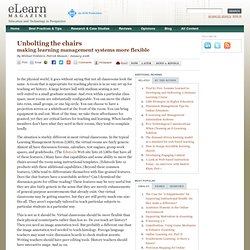
A room that is appropriate for teaching physics is in no way set up for teaching art history. A large lecture hall with stadium seating is not well-suited to a small graduate seminar. And even within a particular class space, most rooms are substantially configurable. You can move the chairs into rows, small groups, or one big circle. You can choose to have a projection screen or a whiteboard at the front of the room. The situation is starkly different in most virtual classrooms. This is not as it should be. Bringing online learning to a research-intensive university. A spirited debate recently arose on the International Forum of Educational Technology & Society (IFETS) listserv.

A (real world) conference had been announced with the aim of "raising awareness of the benefits of using online technologies in supporting teaching, learning and assessment, with a particular emphasis on the impact of e learning. " A university was organizing this conference and aiming it at the university sector. Contributors to the IFETS listserv questioned whether there was still a need for conferences on this topic. In my experience at the University College Dublin (UCD), understanding of the online medium's potential among faculty has always appeared limited.